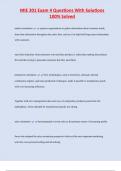Exam (elaborations)
MIE 201 Exam 4 Questions With Solutions 100% Solved
MIE 201 Exam 4 Questions With Solutions
100% Solved
market orientation requires organizations to gather information about customer needs,
share that information throughout the entire firm, and use it to help build long-term relationships
with customers
must first determine what customers wa...
[Show more]
Preview 4 out of 36 pages
Uploaded on
October 7, 2024
Number of pages
36
Written in
2024/2025
Type
Exam (elaborations)
Contains
Questions & answers
Institution
MIE 201
Course
MIE 201
$19.99
Also available in package deal from $31.37
100% satisfaction guarantee
Immediately available after payment
Both online and in PDF
No strings attached
Also available in package deal (1)
$ 584.70
$ 31.37
30 items
1. Exam (elaborations) - Mie 201 test 1 (chapters 1-4) questions with solutions 100% solved
2. Exam (elaborations) - Mie 201 test #1 – makanui questions with solutions 100% solved
3. Exam (elaborations) - Mie 201 ncsu exam 5 review questions with solutions 100% solved
4. Exam (elaborations) - Mie 201 midterm #2 – makanui questions with solutions 100% solved
5. Exam (elaborations) - Mie 201 test 5 makanui questions with solutions 100% solved
6. Exam (elaborations) - Mie 201 test 4 makanui questions with solutions 100% solved
7. Exam (elaborations) - Mie 201 test 3 makanui questions with solutions 100% solved
8. Exam (elaborations) - Mie 201 test 1 questions with solutions 100% solved
9. Exam (elaborations) - Mie 201 test 1 makanui questions with solutions 100% solved
10. Exam (elaborations) - Mie 201- exam 4 questions with solutions 100% solved
11. Exam (elaborations) - Mie 201 exam 4 ncsu questions with solutions 100% solved
12. Exam (elaborations) - Mie 201 exam 4 (11,12,13) makanui questions with solutions 100% solved
13. Exam (elaborations) - Mie 201 exam 3 questions with solutions 100% solved
14. Exam (elaborations) - Mie 201 final exam questions with solutions 100% solved
15. Exam (elaborations) - Mie 201 exam 5 smartbooks questions with solutions 100% solved
16. Exam (elaborations) - Mie 201 exam 5 ratio's questions with solutions 100% solved
17. Exam (elaborations) - Mie 201 exam 5 questions with solutions 100% solved
18. Exam (elaborations) - Mie 201 exam 4 questions with solutions 100% solved
19. Exam (elaborations) - Mie 201 exam #1 questions with solutions 100% solved
20. Exam (elaborations) - Mie 201 chapters 1-3 (test 1) questions with solutions 100% solved
21. Exam (elaborations) - Mie 201 exam 3 (chapters 6, 7, 9, and 10) questions with solutions 100% solved
22. Exam (elaborations) - Mie 201 exam 2 questions with solutions 100% solved
23. Exam (elaborations) - Mie 201 exam 2: chapters 4, 5, 8 makanui ncsu questions with solutions 100% solved
24. Exam (elaborations) - Mie 201 exam 1 questions with solutions 100% solved
25. Exam (elaborations) - Mie 201 exam 1 questions with solutions 100% solved
26. Exam (elaborations) - Mie 201 exam 1 questions with solutions 100% solved
27. Exam (elaborations) - Mie 201 exam #5 questions with solutions 100% solved
28. Exam (elaborations) - Mie 201 exam #1 questions with solutions 100% solved
29. Exam (elaborations) - Mie 201 test 5 (chapters 14,15,16) questions with solutions 100% solved
30. Exam (elaborations) - Connect question for mie 201 exam 1 questions with solutions 100% solved
Show more
MIE 201 Exam 4 Questions With Solutions




